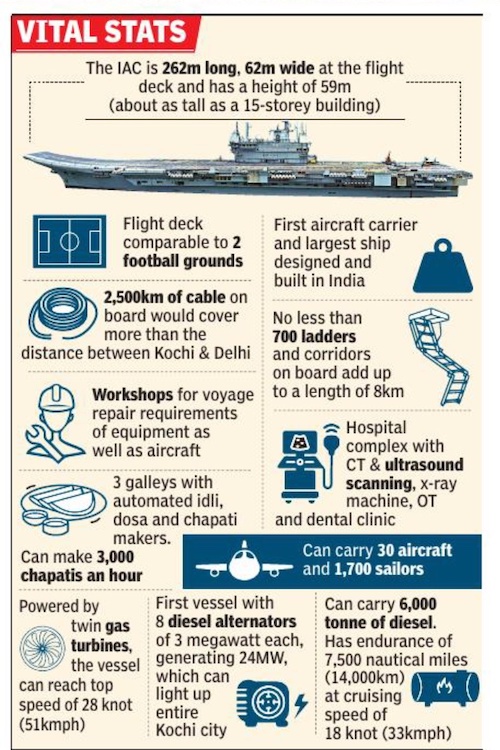Cochin Shipyard Limited
This is a collection of articles archived for the excellence of their content. |
INS Vikrant
2022
AnanthaNarayanan K, August 13, 2022: The Times of India

From: AnanthaNarayanan K, August 13, 2022: The Times of India
In its very first sea trial last August, INS Vikrant achieved the top speed of 28 knots, a rarity for a defence vessel its size and power anywhere in the world, yet, at a certain point, India’s first indigenous aircraft carrier (IAC) had been in real danger of being left high and dry. In nautical parlance, they call it ‘hull slaughtering’. The incident happened in the lead-up to the ship’s official launch in 2013. Cochin Shipyard Limited (CSL), the ship’s builders, wanted a functional launch, one that would see the 45,000-tonne leviathan slide effortlessly from dry dock into the water. But the Navy wanted the frills as well — what’s an aircraft carrier without its skijump (the curving, elevated portion of the flight deck used to launch fighter jets), they asked, and rightly so. The ski-jump would mean an extra 330 tons and, as it were, the Kochi dry dock could just about take the ship’s bare-bones weight. There was a real possibility that the ship wouldn’t budge, or its hull could be damaged. The project’s Russian consultants said they could find a solution but demanded a prohibitive price. Left with no choice, the CSL’s engineers improvised — they put together a buoyancy pontoon (huge steel balloons that from either side provided ballast to lift the ship) and it worked just fine. “CSL designed the special pontoon and simulated it several times. The Russians were dumbstruck. We had combined available technology and some out-of-the-box thinking,” said NV Suresh Babu, former director (operations) of CSL and a current adviser to the shipyard. A mix of indigenous technology and lateral thinking has been the story behind the building of India’s IAC that started formally in 2004 and ended on July 28 when the ship was handed over to the Navy. The IAC, to be commissioned in the Indian Navy as INS Vikrant, is 262m-long, or the size of two football fields, and is the biggest ship built in India. When the project contract was first awarded to CSL, a commercial shipyard that had no experience in making a warship, there was scepticism. “Now we are one of the very few shipbuilders who have built an aircraft carrier and that earns a lot of respect to all,” said Madhu S Nair, chairman and managing director of CSL.
TRIAL AND ERROR
Conceived in the late 1990s, it was the first time a project of such magnitude was being implemented in India. The only experience CSL had with defence vessels was the repair and refits of INS Viraat. However, CSL’s experience in building large tankers and bulk carriers was an advantage. Another challenge was procuring steel as IAC is the first ship to be built in India using indigenously developed special-grade high tensile steel (DMR 249). The inital plan was to procure it from Russia. Later, the Defence Metallurgical Research Laboratory developed the steel indigenously and Steel Authority of India Limited produced nearly 22,000 tonne. IAC has the most complex integrated platform management systems (IPMS), considered the brain that keeps the vessel ‘alive’, ever built in India. Due to its complexity, CSL and Navy decided to do an integrated trial of IPMS before integrating it into the ship. The trial was held at the Bharat Heavy Electricals Limited complex in Bengaluru in 2015. “The very first test failed miserably. The team went back to the drawing board and completed the second trial successfully. If the trial had not been held before integration, it could have been much more complex to resolve,” said Anish S, CSL’s deputy manager who played a key role in developing the IAC’s IPMS.
MILES TO GO. . .
Nair said it took a while for everyone to start believing that CSL could actually do the project but the result has borne them out. “It may not be the biggest carrier but we can proudly say IAC is the best carrier in terms of technology, systems etc. It completed all five sea trials with exemplary performance. I would not say we have done everything correctly. But there is a first time for everything. We could easily make another IAC in around 7-8 years,” Madhu Nair said.